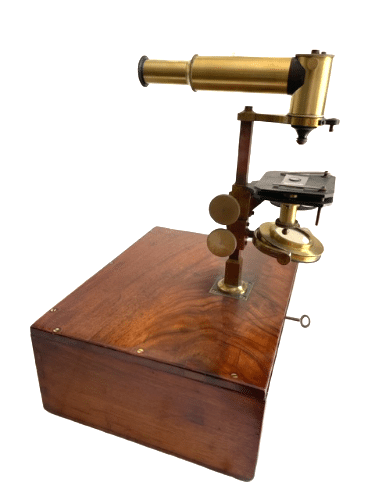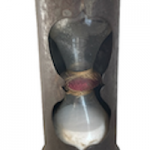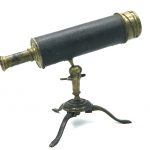Description
Horizontal Achromatic microscope Molteni
An horizontal achromatic microscope is a type of microscope that uses lenses designed to minimize chromatic aberration, which is the distortion of an image due to the different wavelengths of light refracting at different angles. This type of microscope produces images that are more clear and precise than those produced by earlier microscope models.
Molteni is a well-known Italian manufacturer of scientific instruments, including microscopes based in Paris,
Antoine Molteni was the son of Italian immigrant Joseph Antoine Balthazard Molteno (1746/7-1808).
His family was from the Milan area.[2] However, he was born in Bern, Switzerland in 1746 or 47, originally as Giuseppe Molteno.[3][4][citation needed] He travelled to Amsterdam in about 1765, and sold barometers for several years, usually under the name Joseph Molten. He married Johanna (“Jannetjie”) Allen in 1767.[5] The couple had two sons and a daughter Maria Hendrina (Marie-Henriette), but later separated.[6][7] He came to Paris and began trading in optical instruments in 1782 in rue Sainte-Apolline.[8] He and his wife separated at this time too.[9] Joseph Antoine Molteno was instrumental in the creation of the Robertson fantoscope and when he died on 4 April 1808 (aged 62), he passed on the business to his son Antoine.
Italian surnames were changing at the time, as the older system of male, female, and plural suffixes gradually gave way to the modern system whereby the plural “-i” suffix is used consistently throughout. The family therefore used both variants of their surname – Molteno and Molteni.[10]
1824 is universally recognized as the year of the birth of the modern compound achromatic microscope. Giovanni Battista Amici was one of the protagonists on an international level of this event and of the later improvements made to the instrument.
In 1834, Charles Chevalier presented his ‘universal microscope’ that could be arranged as a vertical, horizontal, and inverted (chemical) microscope. Its high price, however, was subject to criticism.
The present microscope demonstrates that Chevalier considered this criticism and developed a smaller and cheaper model, based on his existing small ‘simple and compound model’. He kept the tube, stage, mirror, and optics, but added a second column, as well as two joints and a prism. Ironically, the resulting small universal model could be transformed into a simple microscope as well, contrary to the original and much more expensive large model.
These large model of horizontal achromatic microscope Molteni are difficult to find and more in this size.





